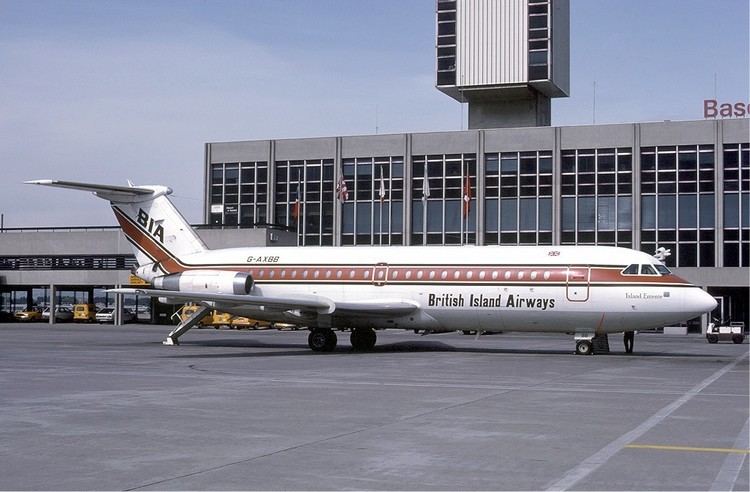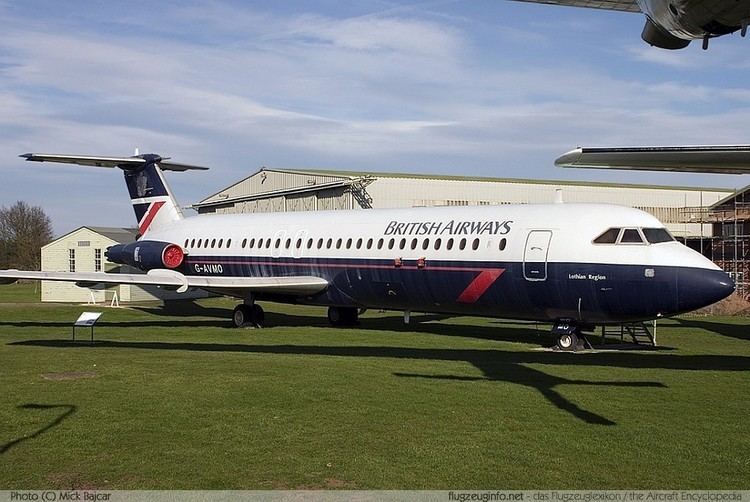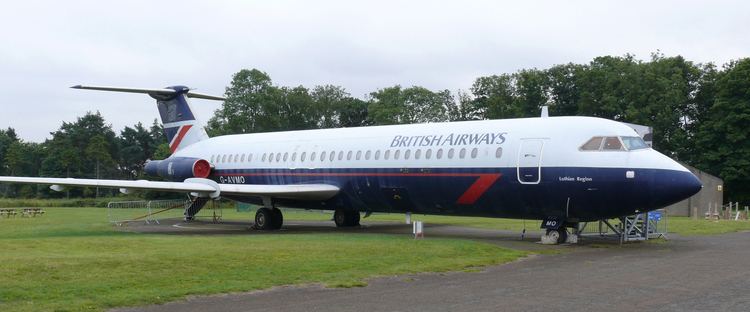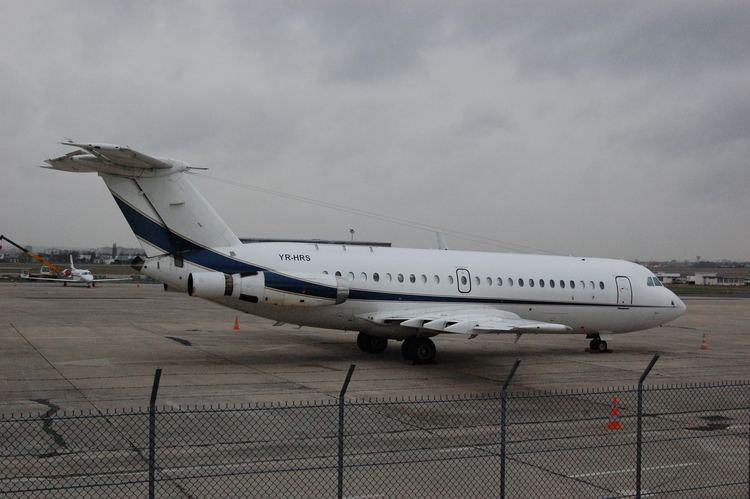Top speed 882 km/h Introduced 1965 | Length 28 m Wingspan 27 m First flight August 20, 1963 | |
 | ||
Manufacturer | ||
Fsx dan air bac one eleven
The British Aircraft Corporation One-Eleven, also known as the BAC-111 or BAC 1-11, was a British short-range jet airliner used during the 1960s and 1970s. It was the second short-haul jet airliner to enter service, following the French Sud Aviation Caravelle. The aircraft was also produced under license in Romania during the 1980s as the Rombac One-Eleven.
Contents
- Fsx dan air bac one eleven
- Early development
- Prototypes
- The One Eleven 500 510ED and 475
- Proposed developments
- Rombac production
- Operational history
- Variants
- Operators
- Notable accidents
- Aircraft on display
- References

The One-Eleven was originally conceived by Hunting Aircraft and was subsequently developed by the British Aircraft Corporation when Hunting merged into BAC along with several other British aircraft manufacturers in 1960. The One-Eleven was intended to replace the earlier turboprop-powered Vickers Viscount on short-range routes. The One-Eleven made it to market ahead of rivals such as the Douglas DC-9-10, which gave it a temporary edge on the market.

The aircraft proved to be popular with domestic airlines and with various international operators; over half of the One-Eleven's sales at launch were to the largest and most lucrative market, the United States. The One-Eleven was one of the most successful British airliner designs and served until a widespread retirement in the 1990s, which was partly due to the introduction of aircraft noise restrictions in many European nations. As of 2013, two examples remain in service as testbeds for Northrop-Grumman.

Early development

In the 1950s, although the pioneering de Havilland Comet jetliner had suffered multiple disasters in service, strong passenger demand for the qualities provided by jet propulsion had been demonstrated. Several aircraft manufacturers raced to release their own passenger jets, including those aimed at the short-haul market, such as the Sud Aviation Caravelle. In July 1956, British European Airways published a paper calling for a "second generation" jet airliner to operate beside their existing turboprop designs. This led to a variety of designs from all of the major players in the British aerospace industry. Hunting Aircraft started design studies on a jet-powered replacement for the successful Vickers Viscount, developing the 30-seat Hunting 107. Around the same time, Vickers started a similar development of a 140-seat derivative of its VC10 project, the VC11. Many other aviation firms had also produced their own designs.

In 1960 Hunting, under British government pressure, merged with Vickers-Armstrongs, Bristol, and English Electric to form the British Aircraft Corporation (BAC). The newly formed BAC decided that the Hunting project had merit, but that there would be little market for a 30-seat jet airliner. The design was reworked into the BAC 107, a 59-seat airliner powered by two 7,000 pounds-force (31 kN) Bristol Siddeley BS75 turbofan engines. BAC also continued development of the larger, 140-seat VC-11 development of the Vickers VC10 which it had inherited. Other competing internal projects, such as the Bristol Type 200, were quickly abandoned following the absorption of Hunting into BAC.

Market research showed that the 59-seat BAC 107 was still too small, and the design was again reworked in 1961, with passenger capacity growing to 80 seats, and the BS75s being discarded in favour of Rolls-Royce Speys. The revised design was redesignated the BAC 111 (later becoming known as the One-Eleven), with BAC abandoning the VC11 project to concentrate on the more promising One-Eleven. Unlike other contemporary British airliners such as the Hawker Siddeley Trident, the One-Eleven was not designed to specifically meet the needs of the state-owned British European Airways or British Overseas Airways Corporation, but on the needs of airlines around the world, and BAC expected that they could receive orders for as many as 400 aircraft. Test flying was conducted by Squadron Leader Dave Glaser.
On 9 May 1961 the One-Eleven was publicly launched when British United Airways (BUA) placed the first order for ten One-Eleven 200s. On 20 October Braniff International Airways in the United States ordered six. Mohawk Airlines sent representatives to Europe seeking out a new aircraft to bring them into the jet era, and on 24 July 1962 concluded an agreement for four One-Elevens. Other orders followed from Kuwait Airways for three, and Central African Airways for two. Braniff subsequently doubled their order to 12, while Aer Lingus ordered four. Western Airlines ordered ten aircraft but later cancelled. Bonanza Air Lines also ordered three One-Elevens in 1962 but was stopped by the U.S. Civil Aeronautics Board (CAB), who claimed that subsidies would be needed to operate a jet on Bonanza's routes, an action which was claimed by some at the time to be protectionism. The CAB also stopped Frontier Airlines and Ozark Air Lines from ordering One-Elevens, although allowing Ozark to order the similar Douglas DC-9 and Frontier to order Boeing 727-100s. The CAB had also unsuccessfully tried to block Mohawk's orders.
In May 1963, BAC announced the One-Eleven 300 and 400. The new versions used the Mk. 511 version of the Spey with increased power, allowing more fuel upload and hence longer range. The difference between the 300 and 400 lay in their equipment and avionics, with the 400 intended for sales in the United States and thus equipped with US instruments. On 17 July 1963, American Airlines ordered 15 aircraft, bringing the order total to 60, plus options for 15 more. American Airlines eventually bought a total of 30 of the 400-series, making the airline the largest ever customer of One-Elevens.
Prototypes
The prototype (G-ASHG) rolled out of the Hurn assembly hall on 28 July 1963, at which point BAC had received orders for the type from a number of operators. On 20 August 1963, the prototype conducted its first flight, painted in BUA's livery. The first flight had taken place almost a year before the Douglas DC-9, a rival American jetliner; BAC considered the BAC to hold a technological edge. The One-Eleven's lead was of significant importance commercially, since — as shown by the Bonanza Air Lines case — US authorities could refuse to approve sales of foreign aircraft to domestic airlines where an American alternative existed.
The One-Eleven prototype, flown by test pilot Mike Lithgow, crashed on 22 October during stall testing, with the loss of all on board. The investigation led to the discovery of what became known as deep stall or superstall, a phenomenon caused by reduced airflow to the tailplane caused by the combined blanking effects of the wing and the aft-mounted engine nacelles at high angles of attack, which prevents recovery of normal (nose-down) flight. To prevent such stalls, BAC designed and added devices known as stick shakers and stick pushers to the One-Eleven's control system. It also redesigned the wing's leading edge to smooth airflow into the engines and over the tailplane. The specially modified aircraft used for testing this problem is now preserved at Brooklands Museum.
Despite the crash, testing continued and customer confidence remained high. American Airlines and Braniff took up their optional orders and placed further ones in February 1964. Further orders came from Mohawk, Philippine Airlines and German businessman Helmut Horten, who ordered the first executive modification of the aircraft. By the end of 1964, 13 aircraft had rolled off the production line. The One-Eleven was certified and the first handover, of G-ASJI to BUA, was on 22 January 1965. After several weeks of route-proving flights, the first revenue service flew on 9 April from Gatwick to Genoa. Braniff took delivery of its first aircraft on 11 March, while Mohawk received its first on 15 May. Deliveries continued, and by the end of 1965 airlines had received 34 aircraft. Demand continued to be buoyant, with a second production line set up at Weybridge - producing 13 1-11s between 1966 and 1970.
The One-Eleven 500, 510ED and 475
In 1967 a larger 119-seat version was introduced as the One-Eleven 500 (also known as Super One-Eleven). This "stretched" version was delayed for at least a year while its launch customer BEA assessed its requirements. This gave competing US aircraft (being the Douglas DC-9 and Boeing 737) the chance to make up for the One-Eleven's early penetration of the U.S. domestic market. The British aircraft's initial one-year advantage now turned into a one-year delay and the stretched series 500 failed to sell in the United States although the type did see service with Cayman Airways and Leeward Islands Air Transport (LIAT) in the Caribbean with Cayman Airways operating the series 500 on scheduled services to Houston, Texas (IAH) and Miami, Florida (MIA), and LIAT flying its series 500s into San Juan, Puerto Rico (SJU). Bahamasair also operated the stretched 500 model with service between Nassau (NAS) and Miami among other routes. Compared with earlier versions, the One-Eleven 500 was longer by 8 ft 4in (2.54 m) ahead of the wing and 5 ft 2in (1.57 m) behind it. The wing span was increased by 5 ft (1.5 m), and the latest Mk. 512 version of the Spey was used. The new version sold reasonably well across the world, particularly to European charter airlines. In 1971 it received an incremental upgrade to reduce drag and reduce runway requirements.
BEA/British Airways 500 series aircraft (denoted One-Eleven 510ED) varied significantly from other One-Elevens, at BEA's request. The One-Eleven 510ED had a modified cockpit which incorporated instrumentation and avionics from or similar to that of the Hawker Siddeley HS.121 Trident, for better commonality with the type. Their additional equipment included a more sophisticated autoflight system, which allowed CAT II autolandings and included an autothrottle. The modifications went as far as reversing the "on" position of most switches to match that of the Trident; indeed, the 510ED was so different from other One-Elevens and 500 series aircraft that a different type rating was required to fly it.
Having faced competition from US aircraft by 1966, by 1970 the One-Eleven also faced competition from newer, smaller aircraft such as the Fokker F28 Fellowship. The F28 was lighter, less complex, and cheaper. The One-Eleven 475 of 1970 was launched to compete with the F28. It combined the 400 fuselage with the higher power and larger wing of the 500 and was intended for hot and high operations, however only 10 One-Eleven Mk 475 were sold. In 1977, the One-Eleven 670, a quiet and updated 475, was offered to the Japanese domestic market, also failing to sell.
Proposed developments
Total deliveries for 1966 stood at 46 aircraft, and another 120 were delivered by 1971. At this point orders slowed to a trickle. British production continued until 1982. There were two reasons why the production line was kept open for just 35 aircraft delivered over 11 years: first, BAC hoped that Rolls-Royce would develop a quieter and more powerful version of the Spey engine, making possible further One-Eleven developments; second, throughout the early part of the period Romania was negotiating to buy the entire One-Eleven programme and transfer production of the type to Bucharest.
By 1974, BAC invested significant effort into launching the One-Eleven 700. This had a longer body with a 134-seat interior and the projected Spey 67 engine producing greater power. It was approximately the same size as the latest DC-9s and 737s and would have been available in time to prevent large-scale defections by One-Eleven clients to McDonnell-Douglas and Boeing. Rolls-Royce was still recovering from bankruptcy, however, and the uprated Spey failed to materialise. An altogether less ambitious 700 made a reappearance in 1978 as a 500 with specially "hush-kitted" Speys which would be replaced by the proposed RB432 in the mid-1980s. This was offered to British Airways in competition with Boeing 737-200s, but was ultimately rejected.
In 1977, BAC merged with Hawker Siddeley to form British Aerospace (BAe) and the One-Eleven 800 was proposed with CFM-56 engines. It would have accommodated some 150 passengers in a mixed class layout. The One-Eleven 800's fate was involved with the development of a European competitor to ubiquitous U.S. short/medium range airliners and it did not progress to the design stage.
The BAC Two-Eleven and Three-Eleven were British airliner studies proposed by the British Aircraft Corporation in the late 1960s which never made it to production.
Rombac production
On 9 June 1979, Romanian president Nicolae Ceauşescu signed a contract for One-Eleven licence production in Romania. This was to involve the delivery of three complete One-Elevens (two 500-series aircraft and one 475 series) plus the construction of at least 22 in Bucharest, with reducing British content. It also involved Romanian production of Spey engines and certification of the aircraft to British standards by the Civil Aviation Authority. A market for up to 80 Romanian-built aircraft was projected at the time, largely in China and other developing economies, and possibly Eastern Europe. The aircraft was redesignated Rombac 1-11.
The first Rombac One-Eleven, (YR-BRA cn 401) a series 561RC was rolled out at Romaero Băneasa factory on 27 August 1982, and flew for the first time on 18 September 1982. Production continued until 1989 at a much slower pace than foreseen in the contract: nine aircraft were delivered, with the 10th and 11th aircraft on the production line abandoned when they were 85% and 70% complete. The first aircraft was delivered to TAROM on 29 December 1982. The Romanian carrier took delivery of all but two of the aircraft produced, with the remaining two going to Romavia, the last of which (YR-BRI cn 409) was delivered on 1 January 1993.
There were three reasons why the Rombac initiative failed: Romania's economy and international position deteriorated to the point where supplies for One-Eleven manufacture slowed to a trickle, with hard currency restrictions delaying the delivery of components that were still sourced outside Romania; the market foreseen by the Romanians failed to show an interest, though some Rombac machines were leased out to European operators; the One-Eleven's noise level and fuel economy had failed to keep pace with US and West European competition.
Adopting a new engine would have resolved noise and fuel economy issues, and following the fall of the Ceauşescu regime, plans were made to restart production using the Rolls-Royce Tay. British aircraft leasing company Associated Aerospace agreed a $1 billion deal to purchase 50 Tay-powered One-Elevens fitted with a new electronic glass cockpit for onward leasing to Western customers. The liquidation of Associated Aerospace in April 1991 stopped this deal, however. Despite this setback, Rombac continued to try to sell the One-Eleven, with US operator Kiwi International Air Lines placing a firm order for 11 Tay-engined aircraft with options for a further five, but these plans came to nothing.
Operational history
Once in service, the One Eleven quickly found itself in direct competition with the Douglas DC-9, and was joined by another competitor, the Boeing 737, only a year after its introduction. Advantages over the DC-9 included a lower unit cost; the DC-9 offered more seating and its engines were interchangeable with those on the Boeing 727. These factors led to Trans Australia Airlines choosing to purchase the DC-9 instead. In the United States, the Civil Aeronautics Board was sceptical of smaller operators' need for jet aircraft and withheld financing, leading to several US customers cancelling their One-Eleven orders.
Mohawk Airlines became both the first American operator of the type and the first airline in the US to operate jet aircraft on short haul routes. On 25 June 1965, Mohawk introduced its first One-Eleven into passenger service; by the end of the decade, the airline operated a fleet of 20 BAC One-Elevens. Buying the jets pushed Mohawk into debt and this, along with an economic downturn and strike action, led to its forced merger with Allegheny Airlines which in turn continued to operate the One-Eleven. In July 1963, American Airlines had placed an order for 15 400-series One-Elevens for £14 million; this was the first time American Airlines had purchased a foreign aircraft type for its fleet. Braniff International Airways, another major U.S. air carrier, also ordered the One-Eleven. Aloha Airlines selected the One-Eleven as its first jet type for interisland service in the Hawaiian Islands.
Several British operators, including Dan Air and British Caledonian, made extensive use of the type. Dan Air progressively increased the number of One-Elevens it had in service in the 1970s, eventually replacing its ageing first-generation de Havilland Comets with the One-Eleven entirely in the 1980s, with the type becoming the airline's main revenue generator. Dan Air would often lease One-Elevens, including Rombac-produced aircraft, to meet short-term demands; during periods of low demand Dan Air would also lease its own One-Elevens out to other operators; British Caledonian and Dan Air One-Elevens would often be exchanged between the two airlines on temporary and permanent arrangements. Passenger demand grew on several key One-Eleven routes, exceeding even the Series 500's larger capacity during the 1980s, which began to force airlines to use other planes.
Prior to the formation of British Airways (BA), some of its predecessor companies, British European Airways and Cambrian Airways, had been operating the One-Eleven. Their fleets were inherited by BA; British Airways Regional Division found the performance of the One-Eleven more than adequate and sought to expand the airline's operations with the type, including further acquisitions, in the early 1970s in part to replace remaining Vickers Viscounts. BA's 400-Series One-Elevens were all named after areas and locations in the English Midlands, reflecting the type's new base at Birmingham Airport. BA ordered more Series-500 aircraft in the late 1970s and the airline received some of the last British-made One-Elevens.
British Caledonian had begun replacing its One-Elevens with the new Airbus A320, when it was merged with British Airways in 1987 due to financial problems. In both Caledonian and British Airways service, the One-Elevens were a dominant type for the operator's European routes. BA proceeded to rationalise its fleets, retiring many overlapping types, the One-Eleven being gradually phased out for the more modern A320 and Boeing 737 jetliners. The last aircraft was removed from regular service with BA in October 1992. A number of ex-BA aircraft saw service with Maersk Air before, in turn, being replaced by the Bombardier CRJ200 in the late 1990s.
In Ireland Aer Lingus flew One-Elevens for three decades, in both the scheduled and charter markets; the aircraft was used on less-busy European routes into the 1990s. The One-Eleven was important in budget airline Ryanair's early years: it had sought an aircraft for low-fare scheduled services from regional airports, and obtained One-Elevens. The first of these, a Rombac-produced 500-Series, entered service on the Dublin–Luton route on 1 December 1986. Ryanair's fleet expanded to six aircraft by 1988, with three leased directly from Romania. These leased aircraft were later replaced with former BA One-Elevens; ultimately Ryanair replaced the One-Eleven with the Boeing 737 in the mid-1990s.
In April 1966, Philippine Airlines began operating One Elevens in revenue service; they eventually operated 12 of the later 500-Series. One of these aircraft suffered two separate in-flight bomb explosions, but was repaired each time and continued in service until 1992. In another high-profile incident on 21 May 1982, John Clearno tried to hijack a Philippine One-Eleven while on the ground but he was eventually overpowered by the cockpit crew following hours of negotiation and no passengers or crew were injured. Philippine Airlines replaced the type with the Boeing 737 from 1989 onwards.
Romania was a major customer for British-produced One-Elevens, with several large orders in the 1970s. These aircraft were often fitted with equipment such as engine 'hush kits'. In May 1977, a major cooperation agreement between British Aerospace and the Romanian government was signed, and this led to a gradual One-Eleven technology transfer to Romania. Full contracts for license production under the Rombac name followed two years later; both complete airframes and components were provided to assist in the venture. All One-Elevens manufactured by Rombac were delivered to TAROM, which leased them to airlines across both Eastern and Western Europe. Rombac-produced One-Elevens would be adopted by many emerging operators across the world, including Lauda Air in Austria, Aero Asia International in Pakistan, and Romavia in Romania.
One-Elevens remained in widespread use with European operators into the 1990s. Once retired from major operators, they were often sold to smaller airlines, often in the Far East and Africa; Nigeria was a major operator until the type was grounded after a crash in 2002. A major factor for the withdrawal from European service of remaining One-Elevens was the Stage III noise abatement regulations, which came into effect from March 2003. Bringing the Rolls-Royce Spey engines into compliance with the noise regulations with hush kits was expensive and many European operators chose to dispose of the type from their fleets instead. In 2010, the European Aviation Safety Agency accepted an Airbus request to revoke the Type Certificate for the BAC One-Eleven. As a result, BAC One-Eleven aircraft registered in any EU Member State are no longer eligible for a normal certificate of airworthiness. In December 2012, the last operational One-Eleven in the UK, which had continued to fly as a military aircraft, was retired.
Variants
Operators
The BAC One-Eleven was widely used by civil and military operators.
As of October 2013 only two aircraft were still in service used by Northrop Grumman as airborne test beds for the F-35 programme, Since the One-Eleven's type certificate has been withdrawn, they fly as experimental aircraft in the research and development category.
